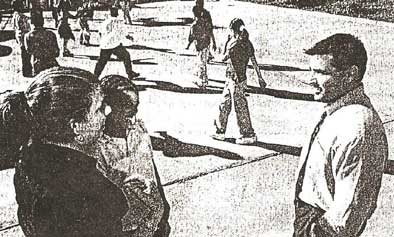School Offers Grueling, Rickety Ride to Success: Without much money, Nativity Prep determines to help students who might otherwise fail
Los Angeles Times (February 19, 2002)
By Deborah Sullivan Brennan

San Diego—The van that shuttles students from Nativity Prep Academy to their swimming lessons and field trips has logged nearly 200,000 miles and is pushing 20 years old. On the outside, it’s a dun-gray clunker.
On the inside, however, it’s a vehicle of opportunity for 19 low-income kids who might otherwise be languishing below grade level in overcrowded public classrooms.
As school founder and President sees it, the vehicle is emblematic of the cash-strapped, first-year school: both struggling day to day to keep going. Housed in a converted warehouse east of downtown, Nativity Prep is a non-profit Catholic school that aims to take children likely to drop out of high school and prepare them to go to college instead. Its first class of 19 fifth-graders studies 12 hours a day–a rigorous regimen of academic basics, enrichment classes and religion–all free to their families.
“Our mission, our dedicated purpose, is to send these children with little hope and less opportunity on to college,” Rivera said.
The school grew out of a religious awakening by Rivera. The son of Latino community leaders in San Diego, Rivera, 34, eschewed their tradition of service in favor of a six-digit income as a real estate agent.
Living in a seaside condo and indulging in what he called “the sin and vice of youth,” he said he had a religious revelation at 25 and decided to return to school. Rivera studied political science at the University of San Diego and obtained a law degree from the University of Notre Dame in 1999.
Returning to San Diego, he researched schools and children’s programs and finally settled on a model developed by Jesuit priests in New York, who started the first “Nativity” school in 1971. The program emphasized intensive instruction, small classes and extended school days.
Enlisting the aid of his alma mater, the University of San Diego, Rivera resolved to open Nativity Prep.
“He’s an incredible salesman,” said Paula Cordeiro, Dean of USD’s School of Education. “It’s hard not to respond to a well-thought-out initiative that is going to help children who are living in poverty.”
Rivera applied the same passion to his quest for funds, piecing together many small donations and a few bigger grants.
“David is a very charismatic, energetic guy on a mission,” said Nativity Prep board member and auto dealer Bob Hoehn, who has donated about $70,000 to the school.
With Nativity Prep’s principal, Bob Heveron, and its educational consultant, Brian Bennett, both veteran Catholic school administrators, Rivera then recruited teachers through the AmeriCorps program. The school hired 10 recent college graduates. The teachers receive $35 weekly stipends, free tuition toward teaching credentials and master’s programs at the University of San Diego, and free room and board.
Nativity Prep opened Sept. 17, welcoming students who were at least two years below grade level academically and from families earning less than $22,000.00 per year. Students start the day at 7 a.m. with the Lord’s Prayer and the Pledge of Allegiance, then move on to breakfast, followed by two-hour blocks of language arts and math. Some afternoons it’s theater and art class; other days it’s music or science.
The students take field trips to Mission Bay, conducting experiments with Aquatics Adventure, a nonprofit educational foundation. On a recent school day, the children, some of whom had never attended a science class before this year, reviewed the salinity, phosphate and fecal coliform levels of a water sample they had tested the week before. Margarita Vera said her son Jose seems to watch less television and be more social since he enrolled. She said his old school, with its large classrooms, “is like a general practitioner, compared to a specialist doctor here.”
The 12-hour school days sound grueling, but students say they’re fun. The long days of work and nights of university classes don’t faze the teachers, either. “It’s been exhilarating, humbling, fun,” said teacher Caroline Sekula, 22. School officials plan to expand the program to include sixth grade next year. For now, though, just keeping the doors open each month has been a labor of love and a leap of faith.
This month its reserves are down to a few thousand dollars. “I’m not worried about the funding, because it will come,” Rivera said.


